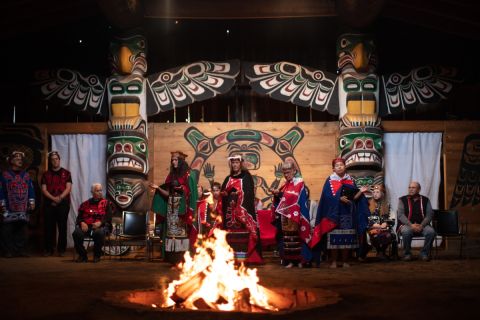
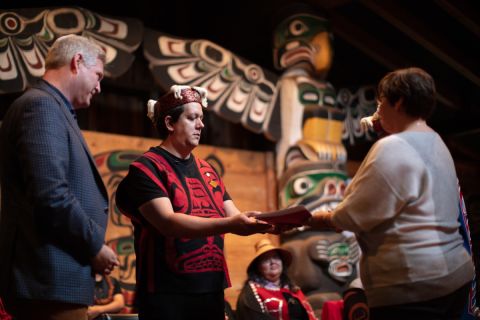
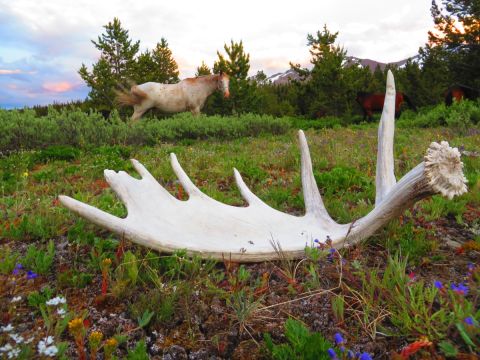
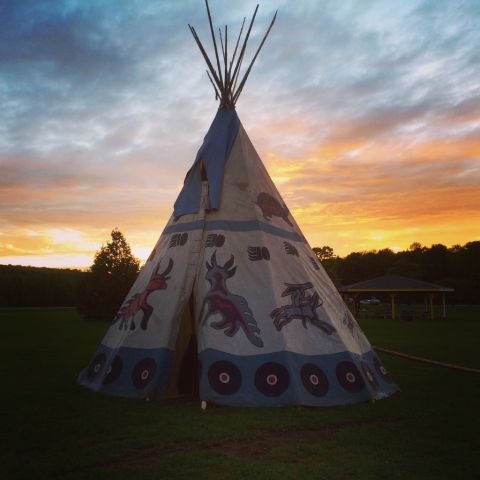
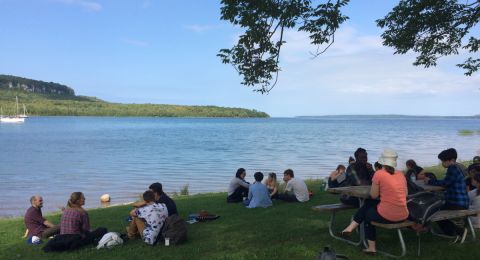
Six legal experts weigh in on revitalizing Indigenous people’s ways of knowing, being, and doing to carve out space for their laws
By Mark Witten
The Canadian legal landscape is shifting. Indigenous ways of knowing, being, and doing are being revitalized and space is being carved out for Indigenous law. Progress can be measured in different ways and to varying degrees, but it’s certain and transformative: Indigenous legal traditions, practices, customs, and beliefs are being considered and applied by the courts, judges, lawyers, and governments in such areas as Aboriginal title, treaty interpretation, self-government and co-management agreements, in family and children’s affairs, legal practice, and the revamping of curriculum and programs in Canadian law schools.
In this multi-segment feature, six Queen’s Law faculty and alumni recognized for their expertise in these matters share their perspectives, experience, and advice on one of the most significant developments in Canadian legal history.
A major awakening came with the Indian Residential Schools Settlement of 2007, the largest class-action in Canadian history, and the resultant Truth and Reconciliation Commission, but it was surely accelerated by the 2021 discoveries of hundreds of children’s unmarked graves on the grounds of Canada’s notorious Indian Residential Schools. Those drew together people of every background in shock and sadness.
“For decades, our First Nation communities knew and talked about the children who didn’t come home,” says Jaimie Lickers, Law’07, VP, Indigenous Markets, CIBC, and previously partner and national leader of Gowling WLG LLP’s Indigenous Law Group. “No one listened and acted on that knowledge. Finding the graves ignited a renewed sense of urgency to address some of the more profound impacts of these tragic events on Indigenous people in this country. Even for non-Indigenous Canadians, it’s easy to care about the children who didn’t come home from residential schools, but I would like to see a similar level of outrage and sympathy for the survivors of those institutions – because they didn’t come back whole from that experience – and a greater resolve to move forward on reconciliation and revitalization in meaningful and substantive ways in the Canadian legal system.”
Self-government agreements create options for Indigenous law-making
First Nations were self-governing long before Europeans arrived in Canada, but in 1876 the Indian Act dismantled their traditional governance and began imposing strict rules on Indigenous peoples’ lives. However, the Constitution Act, 1982 (Section 35), recognized Aboriginal and treaty rights, which are now widely recognized as including inherent, constitutionally protected rights to self-government. Canada’s Act Respecting the United Nations Declaration on the Rights of Indigenous Peoples (UNDRIP) received Royal Assent on June 21, 2021, giving further impetus to advancing Indigenous self-government, a core concept under article 4.
Self-government arrangements between First Nations and both federal and provincial governments, established and administered through a treaty or other negotiated agreement, create space for Indigenous governments to make their own laws pertaining to treaty land and public services for their people – services that may include education, language and culture, health care and social services, police services, housing, property rights, and child welfare.
“Self-government agreements that some Indigenous peoples have with the federal and provincial governments are a good example of how Canadian law increasingly interacts with Indigenous law,” says Hugo Choquette, Law’05, LLM’10, PhD’17, Queen’s Aboriginal Law instructor and Academic Director of the university’s Certificate in Law Program. “Where there are self-government agreements, Indigenous communities are now using their own legal principles and laws. Many already have Indigenous codes of law in writing.”
In 2000, the Nisga’a Nation in northern B.C. became an early trendsetter when it negotiated an agreement with the provincial and federal governments that provided constitutional certainty of its people’s Section 35 right to self-government.
“This agreement gave the Nisga’a a large amount of autonomy to govern themselves according to their own laws,” says Choquette. “But the Indigenous laws are also integrated now within the structure of Canadian law because they’re recognized by federal and provincial law, and there are specific provisions that explain how the laws interact. If there’s a conflict, the agreement explains how it will get resolved.”
Many different self-government models exist, and each Indigenous nation negotiates provisions to meet its unique social, cultural, political, and economic needs. Currently there are some 25 self-government agreements across Canada and at least 50 more being negotiated. On April 6, 2022, five Anishinabek First Nations and the Crown signed the first self-government agreement of its kind in Ontario after 20-plus years of negotiation to implement Anishinaabe law. Any of the other 34 Anishinabek nations can sign on.
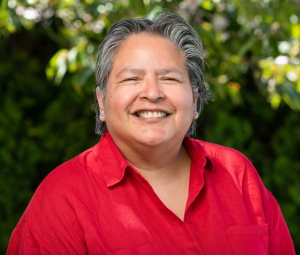
Sara Mainville, Law’04, is pleased. She’s an Anishinaabe lawyer and partner at JFK Law, a leading law firm in Aboriginal legal affairs. “If we are in an era of self-determination, then to define the path forward we must celebrate and respect the achievements of the Anishinabek Nation and the First Nation signatories to build the foundation of nationhood,” she says. “Just as important is the First Nations’ governance capacity now afforded through this agreement. They will decide when their elections will be held, who their citizens are, and how their governments will operate, as well as how best to protect and promote Anishinaabe language and culture. I look forward to seeing these communities create good results by the Anishinabek for the Anishinabek.”
Effective January 1, 2020, Bill C-92, an Act Respecting First Nations, Inuit and Métis, enshrined into law for Indigenous peoples across Canada jurisdiction over child welfare and family services. It leaves their communities and groups free to develop policies and laws based on their particular histories, culture, and circumstances, with the goal of keeping Indigenous children and youth connected to their families, communities, and culture – exactly opposite to the Indian residential schools.
Indigenous Professor Lindsay Borrows considers this bill “a huge step forward, because there are more Indigenous youth out of their homes today than at the height of the residential schools. The empowering legislation is a way to provide the resources to bring children back home.”
Aboriginal law and Indigenous law slowly finding closer ties

Although the terms can be confusing, there is in Canada today a very important difference between Aboriginal law and Indigenous law. As Hugo Choquette explains, “Aboriginal law is the law of the Canadian state as it relates to Indigenous peoples – First Nations, Métis, and Inuit people. In contrast, Indigenous law describes the laws and multiple legal traditions of Indigenous peoples themselves.”
Making the distinction is important, he adds. “It entails recognizing the validity and reality of Indigenous law. Even in recent history we’ve seen where Indigenous law was not considered law at all, as in the Wet’suwet’en First Nation conflict over the Coastal GasLink pipeline in northern B.C. In other conflicts, too, the media oftentimes describes the situation as ‘law’ versus ‘civil disobedience,’ or the ‘absence of law.’ Terming it a ‘conflict of laws’ would rightly see the Wet’suwet’en laws from the Indigenous perspective.”
Slowly but surely, however, Choquette and others see Indigenous law and legal traditions influencing, informing, and impacting Aboriginal law in court processes and decisions, negotiated partnership and development agreements, and self-government agreements.
Necessary and timely: Legal practitioners getting informed about Indigenous perspectives

Given the increased emphasis on bringing an Indigenous perspective and applying Indigenous legal principles to many areas of Canadian law, including business, John Rowinski, Law’00, suggests that both non-Indigenous and Indigenous legal professionals should broaden their legal thinking by seeking to understand and inform themselves about native laws and traditions.
“I think of Indigenous law as informing the way Canadian law is applied to Indigenous peoples,” says Rowinski, a Kanyen’kehá:ka (Mohawk) lawyer who practised for almost two decades, chaired the Ontario Bar Association’s Aboriginal Law Section, and is now CEO of Noozhoo Nokiiyan Limited Partnership, which manages the for-profit enterprises of the Mississaugas of Scugog Island First Nation. “Lawyers representing or interacting with Indigenous clients need to look at the unique circumstances of an Indigenous community rather than just Canadian legal precedents. Non-Indigenous actors should not simply force common law views or solutions onto Indigenous peoples; lawyers should instead seek ways to combine the best and most applicable Indigenous and common law principles into their legal structures, documents, arguments, and practice.”
Rowinski shares an example from his own practice of turning to an Indigenous way of resolving a commercial dispute involving lands on a reserve held by two Indigenous members. “Their dispute was about the boundaries of their lots, established by a poor survey completed decades earlier by the federal government,” he says. “We were moving towards an expensive trial when we found a respected elder from a neighbouring community who heard out both parties and came to a compromise accepted by everyone so that they could live amicably together in their small community. Given how entrenched the parties’ views were, we would have needed a court intervention if not for this traditional Indigenous approach to resolving disputes.”
As more room is made for Indigenous law and legal traditions to assert themselves in mainstream Canadian legal systems, Hugo Choquette believes it’s important for lawyers working with Indigenous clients to learn about these legal principles and traditions and ways to bridge interactions between them and common law or civil law. “The vast majority of lawyers are not trained in law to deal with Indigenous law,” he says. “Opening our minds to the Indigenous perspective in the way legal problems are dealt with is necessary and overdue. For common-law-trained lawyers like me who have an interest in Indigenous law and legal traditions, the best thing we can do is be conscious of the limitations in our knowledge and be open to educating ourselves. That’s key to working effectively with Indigenous clients and their communities.
“Indigenous laws come from Indigenous ways of doing and knowing, and their ways of knowing and extracting laws can be very different; their laws may be contained in observations in nature or in stories such as creation stories,” he adds. “Today there are lots of workshops, seminars, webinars, and other resources to help you learn about how Indigenous law works in general, and how it differs from common law or civil law or other systems. However, in terms of learning specific Indigenous legal traditions, you need to connect to a community and learn from it or its elders. The main thing is building relationships and being open to those interactions.”
Interpreting treaties: new cross-cultural approach
From the 18th to the early 20th centuries, Crown representatives and Indigenous leaders signed constitutionally recognized treaties throughout certain parts of Canada in an effort to resolve issues of outstanding Aboriginal title. (In most of British Columbia, however, Crown representatives did not negotiate with Indigenous peoples, with exceptions such as Vancouver Island’s Douglas treaties and the Peace River region’s Treaty 8.) A cross-cultural approach to interpreting those treaties now considers dual perspectives: the written legal text and the spirit and intent as understood by the Indigenous parties.

“Historically, the courts have struggled to recognize that the written text of the treaty may not represent the actual agreement between the parties,” says Dean Mark Walters, Law’89, a leading scholar in Indigenous peoples’ rights and treaty relations between the Crown and Canada’s First Nations. “Often the Indigenous signatories were unable to read the text because it was not written in their language. There was the possibility of miscommunication as well as a power imbalance between the parties. Over the last 25 years, courts have been wanting to develop principles for interpreting these treaties by including the Indigenous perspective and how those people might have understood the agreements. I’m hopeful judges will soon learn enough about Indigenous principles to apply them better in treaty cases.”
So far, political dialogue and negotiations have proven more effective than litigation in protecting, affirming, and exercising Indigenous rights under existing treaties. Choquette agrees: “So far, in the context of treaties, there is more change and greater willingness to recognize the reality of Indigenous law and perspectives in the political sphere and through negotiated agreements than there is in the courts.”
A landmark Aboriginal title decision informed by dual perspectives
Dean Walters views the evolution of cases involving Aboriginal land title as a striking example of progress made in the meeting of common law and Indigenous law in Canadian courts. “Tsilhqot’in Nation v. British Columbia is the leading case that recognizes Aboriginal title and the right of Indigenous people to their territory,” he says. “It involved the meeting of two sets of legal traditions, and the court recognized the Indigenous legal perspective that ‘according to the nature of our landholding system, this is our territory.’”
In its 2014 ruling – the first declaration of Aboriginal title in Canadian history – the Supreme Court of Canada (SCC) granted declaration of title to more than 1,700 square kilometres of land near Williams Lake in the B.C. interior. The Tsilhqot’in people argued that a B.C. Court of Appeal ruling had failed to recognize the semi-nomadic way its people had lived for centuries, with few permanent encampments, even though the Tsilhqot’in saw the area as their own and protected it from outsiders. In its decision, the SCC agreed that a semi-nomadic people can claim land title even for seasonal use of the land. It then set out a three-point test to determine eligible lands: occupation, continuity of habituation, and exclusivity in the area.
In its written decision, the Court emphasized the importance of considering the dual perspectives of common law and Indigenous law, recommending a culturally sensitive approach to sufficiency of occupation based on the dual perspectives of the applicant Aboriginal group’s laws, practices, size, technological ability, the character of the land claimed, and the common law notion of possession as a basis of title. Further, it said the common law test for possession (an intention to occupy or hold land for the occupant’s purposes) must be considered alongside the Indigenous group’s size, manner of living, and resultant legal perspective on the possession of land.
Indigenous legal perspective and traditions also informed the lengthy B.C. Supreme Court trial from 2002 to 2007. Justice David Vickers heard the laws contained in their oral history as evidence over 339 days of testimony, and the Court sat for five weeks at the Naghataneqed Elementary School in Tsilhqot’in territory.
Ratifying Indigenous art and nature as legal entities
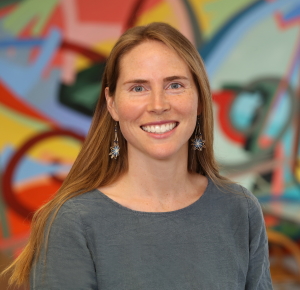
Professor Lindsay Borrows, an Anishinaabe lawyer, teacher, and legal traditions scholar, joined Queen’s Law on July 1, 2022. After her B.C. experience providing legal support and research for First Nations articulating and implementing their Indigenous laws, she sees innovations in the drafting of legally binding contracts through Indigenous traditions as an exciting development in bringing common law and Indigenous law closer together.
Borrows cites the example of the Witness Blanket, a 2-by-12-metre art installation created by Carey Newman (Hayalthkin’geme), a Kwakwaka’wakw and Coast Salish artist. He spent a year visiting 77 communities to hear stories of residential school survivors and gathered 887 physical pieces of history from them to produce the Witness Blanket in his Victoria studio. After the Canadian Museum for Human Rights (CMHR) recognized its national importance and approached him about acting as its caretaker, Newman proposed an Indigenous-based legal arrangement.
“He didn’t want to use the usual contractual model for transferring ownership of the work to the museum, because it would effectively end his relationship with the piece. Instead, he co-drafted an agreement using Kwakwaka’wakw law. In it, the blanket is considered to be alive, and as a legal entity it is a party to the agreement, along with Newman and the CMHR. So it is the beginning of a relationship, not the end. Unlike many standard contracts, it is not a permanent transfer of property,” explains Borrows. She attended the 2019 ceremony at the K’ómoks Bighouse, in the Comox Valley on Vancouver Island, to ratify this novel, legally binding contract.
She also cites the global Indigenous-led “Rights of Nature” movement, where Nations are reinterpreting existing legal categories like personhood as a tool to uphold their obligations to the natural world. For example, in New Zealand, different Māori iwi (tribes) negotiated caretaking arrangements for the Whanganui River and for Te Urewera, a former national park, by recognizing their personhood. In Quebec’s Côte-Nord region, Innu First Nations have cherished the Magpie River (Muteshekau Shipu) as a highway and a place of healing for thousands of years, recognizing it has a spirit and is alive. In 2021, joint rulings from the Innu Council of Ekuanitshit and the regional municipality of Minganie formally declared the majestic Magpie a legal person with nine rights that include to be free of pollution and hydroelectric development, to sue, and to have legal guardians – a first in Canada. Borrows sees these examples as hopeful environmental decision-making paths that offer an alternative to adversarial court proceedings.
Negotiations that harmonize Indigenous and Western ways
Sara Mainville, Law’04, an Anishinaabe lawyer and partner at JFK Law, a leading law firm in Aboriginal legal affairs, brings a wealth of experience as a lawyer and advisor to First Nation governments engaging federal and provincial governments in Treaty 3 land negotiations. Treaty 3, signed in 1873, covers 55,000 square miles of Anishinaabe Nation territory in northwestern Ontario and eastern Manitoba.
In a powerful example from 2020, Mainville, of Couchiching First Nation, cites Treaty 3 Anishinaabe leaders negotiating an agreement with Ontario’s Ministry of Transportation on a project that involved widening and twinning the TransCanada Highway between Kenora and the Manitoba border. The agreement guides the project, since parts of the highway pass through four Indigenous communities’ traditional territories, and an environmental assessment based on Anishinaabe knowledge, laws, and protocols was carried out. The consultation and accommodation process involved mutual respect for the treaty partnership, she says. “That was key to reaching a successful negotiated agreement to proceed with the project.”
“It wasn’t just Canadian law but also Indigenous law that made the treaties, and so recognizing and honouring the two legal traditions sets a sound basis for negotiations today,” Mainville explains. “On the highway twinning and many other projects, the Anishinaabe Nation in Treaty 3 has demonstrated that the Crown’s duty to consult and accommodate can be a win-win. We’re trying to create certainty for people who come into our territory. This is done by following our Great Earth Law, a process that involves meeting with us, learning who we are, telling us what you want to do, changing the plan if necessary, and determining how to go forward together.”
Lindsay Borrows also believes that co-management agreements, such as the historic Haida Kunst’aa Guu - Kunst’aayah Reconciliation Protocol between the Haida Nation and the B.C. government in 2009, can be effective models for shared decision-making with respect to land use and resource development, even when the two parties hold differing views regarding sovereignty, title, ownership, and jurisdiction. Under the protocol, representatives from both the Haida and B.C. governments are jointly responsible for assessing development applications from the beginning, helping to ensure the Haida can make sustainable land use decisions for the socioeconomic benefit of their members.
Enriched study of Indigenous law and legal traditions begins at Queen’s
Professor Borrows, who specializes in Indigenous legal traditions, has practised Indigenous law and environmental law in Vancouver and spent two years as a lawyer with the University of Victoria’s Indigenous Law Research Unit (where she had been a student researcher), is offering Queen’s Law students an opportunity to develop and enrich their understanding of Indigenous law through the lens of innovative land-based and community-based learning experiences. This academic year, she is teaching two new upper-year courses: Indigenous Law in Practice and Indigenous Governance and Environmental Law.
“The first course surveys what’s happening in the Indigenous law field,” she says. “One key to teaching Indigenous legal traditions is to introduce a variety of community-based voices. Indigenous people live all across the country; there are 12 different Indigenous language families with over 60 languages spoken in total. Just as nations have their own distinctive languages, they also have their own laws and legal traditions, and it’s important to help students see this great diversity.”
Borrows’ courses also present key methods of revitalizing these traditions. She has co-taught land-based Anishinaabe law camps in her home community of Neyaashiinigmiing (Chippewas of Nawash First Nation) in Georgian Bay’s Saugeen peninsula and in several other communities in southern Ontario. “The narrative method involves telling stories and identifying the main legal issues in them,” she says. “Indigenous communities created laws through these stories for thousands of years. Land-based learning involves students spending time out on the land to learn what the earth teaches us. By observing nature, students understand how lessons from nature flow into Indigenous law.”
In Indigenous Governance and Environmental Law this term, her students will learn how First Nations are upholding their own traditional laws and collective responsibilities towards lands and waters through co-management agreements, treaties, and Aboriginal rights and title. “I will be taking students out onto the land for three-hour classes,” she says. “For Queen’s Indigenous law courses in current and future years, we’re also seeking long-term funding for immersive multi-day learning experiences where students will go into Indigenous communities to witness Anishinaabe law in practice and learn through observation and hands-on engagement. It will be so powerful for students to sit in a council conversation and witness the process!”
Choquette sees his colleague’s background as a vital asset in teaching Indigenous law. “You need particular training, connections, and relationships, which Lindsay Borrows has, and she is going to be part of that trend toward an increasing amount of Indigenous law within the Queen’s Law curriculum.”
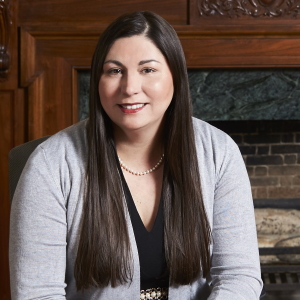
Jaimie Lickers, who is regularly invited to guest lecture on Indigenous trust and tax law at law schools across the country, also believes law schools need to support the development and training of more Indigenous scholars to accelerate this reconciliation. “We need to encourage and engage more Indigenous law students to pursue careers in academia, and it should be a particular type of person and student who will have that passion for academic research and the skills to be an excellent teacher,” she says. “In the interim, it’s very beneficial to fill curricular gaps with Indigenous experts in various practice areas. Indigenous guest lecturers with specialized expertise can also be excellent tools for students and existing faculty to educate themselves on Indigenous law and principles.”
In the Queen’s Certificate in Law Program’s Aboriginal Law course, Choquette teaches undergraduate students how Indigenous law interweaves with Canadian law, and students learn about the differences in Western and Indigenous traditions of legal reasoning and argumentation. He says that as a non-Indigenous professor, he gains new insights and a deeper understanding of the Indigenous perspective when students with long working experience in Indigenous communities bring their direct, hands-on experience, their understanding and perspective, to share with other students. “This timely course is a tremendous place for students to interact and to learn and discuss these issues,” he says.
Long-overdue Indigenous representation will bring new vitality to Supreme Court
Although cases involving Indigenous treaty rights, Aboriginal title, and the status of Indigenous legal traditions in relation to Canadian common law have preoccupied the Supreme Court of Canada for over three decades, until the summer of 2022 there had not been a single Indigenous justice on the Court to participate in adjudicating these cases. Those watching and waiting hoped that Justice Michael Moldaver’s September 1 retirement could be the opportunity to appoint the SCC’s first Indigenous justice, and so it was. On August 19, the Prime Minister announced a candidate who instantly became a historic figure: Michelle O’Bonsawin, an Abenaki member of northern Ontario’s Odanak First Nation and a Superior Court justice since 2017. Her SCC appointment was enthusiastically endorsed by Parliament and welcomed by the Assembly of First Nations.
Sara Mainville had long called this an “urgent necessity.” “To better reflect and safeguard Indigenous legal systems, it’s so important to have an Indigenous person on that bench who understands Indigenous principles and sees the law from the Indigenous perspective,” she says. “The appointment is long overdue, coming 40 years after the recognition of Indigenous rights in Section 35 of the Constitution.”
For this particular SCC justice, no exception had to be made to the federal government’s functional bilingualism requirement. Franco-Ontarian O’Bonsawin is fluently bilingual. Jaimie Lickers admits that “the restriction for a candidate to be more than competent in French has been a huge impediment, and deeply offensive to Indigenous people whose languages are not officially recognized in Canada. While not an impediment for this historic appointment, the French language requirement continues to be a barrier for other worthy candidates.”
Dean Walters expects that finally having Indigenous representation on the country’s highest court will also have significant impact and influence on courts and judges at all levels of the Canadian legal system. “Having an Indigenous voice on the court will send an extremely important signal, because if there is a structural problem with how Canadian courts operate in terms of considering Indigenous law and traditions, and how these are interpreted by judges, having this Indigenous judge at the highest level can only help.”
* * * * * *
It’s been a long time coming, but transformative change is under way across Canada’s legal landscape.
All the forward steps described and prescribed above are meaningful building blocks but just the early stages of a journey towards a multi-juridical system in which common, civil, and Indigenous law truly co-exist and inform each other.
As Hugo Choquette put it, “Opening our minds to the Indigenous perspective in the way legal problems are dealt with is necessary and overdue.”